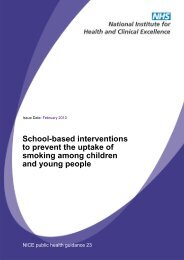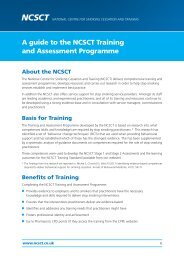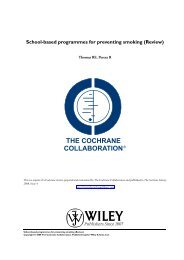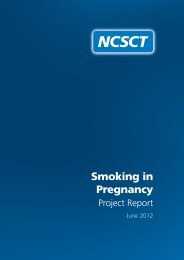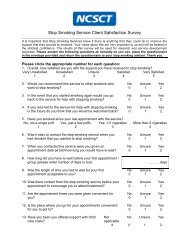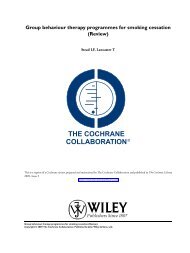Smoking and mental health - NCSCT
Smoking and mental health - NCSCT
Smoking and mental health - NCSCT
You also want an ePaper? Increase the reach of your titles
YUMPU automatically turns print PDFs into web optimized ePapers that Google loves.
<strong>Smoking</strong> <strong>and</strong> <strong>mental</strong> <strong>health</strong><br />
1.41–1.92) for telephone support. 4 There is as yet insufficient information to<br />
determine which elements of behavioural support are effective, or whether one<br />
approach, such as motivational interviewing or cognitive–behavioural therapy, is<br />
more effective than another. However it appears that group support is generally<br />
more effective than one-to-one support, <strong>and</strong> that support should involve<br />
multiple sessions. 28<br />
In people with SMI, a study comparing a specialist quit smoking programme<br />
with st<strong>and</strong>ard smoking cessation group therapy, both delivered together with<br />
NRT, 29 found no difference in point prevalence abstinence at the primary trial<br />
endpoint of 3 months (relative risk (RR) of smoking = 1.01, 95% CI 0.45–2.28),<br />
although there was a non-significant reduction in smoking risk at the last time<br />
point of the study (8.5 months; RR = 0.61, 95% CI 0.14–2.67). Baker et al 30<br />
compared the effectiveness of individual therapy (cognitive–behavioural therapy<br />
<strong>and</strong> motivational enhancement) plus NRT with usual care (booklets <strong>and</strong> access<br />
to primary care) without NRT among participants with SMI, predominantly<br />
schizophrenia. At 4 months (the trial endpoint), the intervention group were<br />
significantly more likely to abstain from smoking (RR = 2.74, 95% CI 1.10–6.81),<br />
although this effect was not sustained in later comparisons <strong>and</strong> the effect<br />
attributable to the behavioural intervention (as opposed to the NRT) is unclear.<br />
Thus, there is evidence that behavioural support delivered with NRT is effective<br />
in SMI, but no strong evidence that tailored behavioural interventions are more<br />
effective than st<strong>and</strong>ard group therapy.<br />
5.2.2 Nicotine replacement therapy<br />
A meta-analysis of more than 100 r<strong>and</strong>omised controlled trials in general<br />
populations 9 has demonstrated that all forms of NRT (including transdermal<br />
patches, gum, inhalator, nasal spray, lozenges <strong>and</strong> others) are similarly effective in<br />
aiding long-term cessation (overall OR 1.77, 95% CI 1.66–1.88), <strong>and</strong> that<br />
combinations of slower (transdermal patches) <strong>and</strong> faster-acting NRT<br />
formulations (oral or nasal delivery products) are more effective than either<br />
formulation alone.<br />
Use of NRT in people with SMI has not been subject to large-scale clinical<br />
trials, although there are no grounds to suspect that NRT is likely to be<br />
ineffective in this population. However, smokers with SMI tend to smoke more<br />
cigarettes, 31,32 <strong>and</strong> to smoke each cigarette more intensely <strong>and</strong> hence extract<br />
more nicotine from each cigarette, 33 so the severity of nicotine withdrawal<br />
symptoms is likely to be particularly intense in this group. As in the general<br />
population of more dependent smokers, it is therefore probably especially<br />
important to use combination NRT, 9 supplementing a transdermal patch with a<br />
faster-acting product (of which the nasal spray may be particularly effective 34 ), in<br />
people with SMI. It is also probably important to continue NRT for longer than<br />
the typically recommended 8–12 weeks, <strong>and</strong> indeed to consider long-term<br />
86 © Royal College of Physicians 2013




